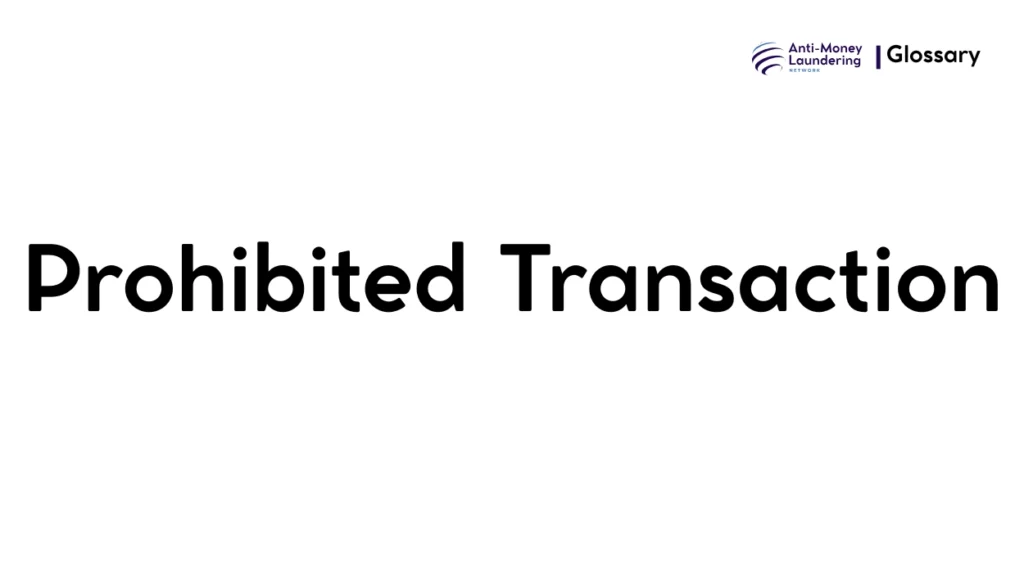Definition
In Anti-Money Laundering (AML) terminology, a “Prohibited Transaction” refers to any transaction, investment, undertaking, or activity that conceals the true identity, source, or destination of proceeds derived from illicit activities. It also covers transactions that involve the direct or indirect facilitation of illegal funds entering or moving through the financial system, thereby circumventing regulatory controls intended to prevent money laundering and terrorist financing. Such transactions are explicitly forbidden under applicable AML laws and regulations to disrupt criminal exploitation of financial services.
Purpose and Regulatory Basis
The primary purpose of defining and enforcing prohibitions against certain transactions is to prevent criminals from legitimizing illicit funds and to deter the misuse of financial institutions for money laundering, terrorist financing, or other illicit activities. Regulating prohibited transactions is critical to safeguard the integrity of the financial system and support global efforts to combat financial crime.
Key international and national regulatory frameworks addressing prohibited transactions include:
- The Financial Action Task Force (FATF) Recommendations, which set global standards for AML/CFT, reinforcing restrictions on suspicious or illicit transactions.
- The USA PATRIOT Act, particularly its Section 312 and Sections on suspicious activity reporting, which impose stringent controls on financial institutions to detect and block prohibited transactions.
- The European Union’s Anti-Money Laundering Directives (AMLD), which mandate member states to criminalize and prevent prohibited transactions as part of a comprehensive AML regime.
These regulations mandate financial institutions and other obligated entities to identify, monitor, and report prohibited transactions and to implement internal controls to prevent their execution.
When and How it Applies
Prohibited transactions apply whenever there is an attempt to conduct financial or commercial operations that might mask the illicit nature of funds or involve sanctioned individuals, entities, or activities. Real-world triggers include:
- Large cash transactions involving suspicious or unverified sources.
- Transfers or investments linked to persons or jurisdictions subject to sanctions or regulatory restrictions.
- Transactions structured to evade reporting thresholds or internal monitoring controls.
- Acquisition or sale of high-value goods or assets (e.g., precious metals, vehicles) that may serve as vehicles for laundering illicit funds.
For example, a financial institution may block or refuse a wire transfer if it detects signs of layering intended to obscure the origin of funds, or a trade-based money laundering scheme involving false invoicing.
Types or Variants of Prohibited Transactions
Prohibited transactions can manifest in various forms, including:
- Cash transaction prohibitions: Restrictions on cash dealings above certain thresholds in specific goods or services (e.g., jewelry, vehicles).
- Sanctioned transactions: Operations involving persons, countries, or entities on financial sanctions lists.
- Structuring or smurfing: Deliberate splitting of transactions to avoid detection.
- Unlawful transfers: Transactions involving proceeds from predicate crimes like drug trafficking, corruption, or fraud.
Each classification represents different mechanisms used by criminals and requires tailored controls.
Procedures and Implementation
Institutions must establish robust measures to comply with prohibited transaction regulations, including:
- Customer Due Diligence (CDD) and Enhanced Due Diligence (EDD) to assess risks and identify suspicious activities.
- Implementation of transaction monitoring systems that flag unusual patterns, amounts, or counterparties.
- Development of policies and protocols to freeze or reject prohibited transactions promptly.
- Staff training on recognizing and handling prohibited transactions.
- Regular internal audits and compliance reviews to ensure adherence to AML requirements.
These steps are combined with ongoing risk assessment and updated compliance frameworks.
Impact on Customers/Clients
From the customer or client perspective, prohibitions mean certain transactions may be restricted or declined. Customers are subject to identity verification and may experience delays or inquiries for transactions deemed high risk. Rights to contest or appeal decisions vary by jurisdiction but are generally balanced with regulatory obligations to prevent illicit activity. Transparency about the institution’s AML policies and customer obligations enhances compliance and trust.
Duration, Review, and Resolution
Prohibited transactions may be temporarily held or permanently blocked depending on internal policies and regulatory directives. Financial institutions must review flagged transactions promptly, escalate suspicious cases to AML officers, and cooperate with authorities for resolution. Ongoing obligations include transaction monitoring, updated sanctions screening, and readiness for audits or investigations. Reviews are typically periodic and aligned with regulatory reporting cycles.
Reporting and Compliance Duties
Institutions bear the responsibility to:
- Document all prohibited transactions or attempts, with details supporting the compliance review.
- Report suspicious or prohibited transactions to relevant Financial Intelligence Units (FIUs) or regulatory bodies.
- Maintain audit trails to demonstrate adherence to AML laws.
- Face penalties for non-compliance, including fines, reputational damage, or legal sanctions.
Effective reporting enables broader financial crime disruption efforts and regulatory enforcement.
Related AML Terms
Prohibited transactions connect closely with other AML concepts such as:
- Suspicious Activity Reports (SARs).
- Sanctions compliance.
- Customer Due Diligence (CDD).
- Transaction monitoring.
- Money laundering predicate offenses.
- High-risk jurisdictions and persons.
Understanding these interrelations is vital for comprehensive AML compliance programs.
Challenges and Best Practices
Common challenges include detection of complex layering schemes, evolving typologies of prohibited transactions, and balancing customer experience with regulatory rigour. Best practices involve leveraging advanced analytics, continuous staff training, technology investments in real-time monitoring, and fostering a strong compliance culture supported by senior management.
Recent Developments
Recent trends enhancing the management of prohibited transactions include increased regulatory clarity, automation with AI-driven transaction analysis, expanded sanctions regimes, and tighter controls on cash transactions in trade sectors. Legislative updates in various jurisdictions continue to close loopholes and enhance transparency
Prohibited transactions are at the core of AML efforts, defined as transactions that conceal illicit origins or otherwise violate AML regulations. They serve as critical control points for financial institutions to prevent money laundering and terrorist financing under global regulatory standards such as FATF, the USA PATRIOT Act, and EU AML directives. By implementing systematic procedures and maintaining vigilant monitoring, institutions uphold compliance and protect the financial system’s integrity.

